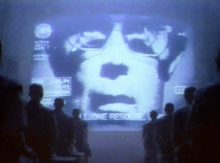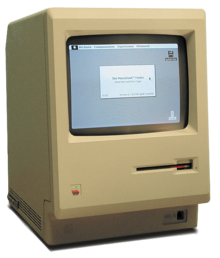1984 (advertisement)
| 1984 (Apple commercial) | |
|---|---|
| Directed by | Ridley Scott |
| Written by | Lee Clow Steve Hayden |
| Produced by | Chiat/Day |
| Starring | Anya Major David Graham |
| Distributed by | Apple Computers |
Release dates | 22 January, 1984 (only daytime televised broadcast) |
Running time | 30 seconds (final cut) |
| Country | |
| Language | English |
1984 is the American television commercial which introduced the Macintosh personal computer for the first time. It is now considered a "watershed event" [1] and a "masterpiece."[2] It was directed by Ridley Scott, written by Steve Hayden and Lee Clow, and was produced by Chiat/Day. Costume designer Jeanette Farrier [3] designed the costumes for the commercial. [citation needed] Anya Major performed as the unnamed heroine and David Graham as "Big Brother." [4][5] Its only daytime televised broadcast was on 22 January, 1984 during the third quarter of Super Bowl XVIII. [6] Chiat/Day also ran the ad one other time on television, a month earlier at 1:00 A.M on 15 December 1983 on KMVT in Twin Falls, Idaho so that the advertisement could be submitted to award ceremonies for that year. [7][8] In addition, starting on 17 January 1984 it was screened prior to previews in movie theaters for a few weeks. [7]
1984 used the unnamed heroine to represent the coming of the Macintosh (indicated by her white tank top with a Picasso-style picture of Apple’s Macintosh computer on it) as a means of saving humanity from "conformity" (Big Brother). [9]
These images were an allusion to George Orwell's noted novel, Nineteen Eighty-Four, which described a dystopian future ruled by a televised "Big Brother."
Plot
The commercial opens with a dystopic, industrial setting in blue and gray tones, showing a line of people (of ambiguous gender) marching in unison. They are moving through a long tunnel monitored by a string of televisions. This is in sharp contrast to the full-color shots of the nameless heroine (Anya Major) who has appeared to rescue them. She looks more like an Olympic track and field athlete than a soldier, as she is carrying a large brass-headed hammer and is wearing an athletic "uniform" (bright orange athletic shorts, running shoes, a white tank top with a Picasso-style picture of Apple’s Macintosh computer, a white sweat band on her left wrist, and a red one on her right).[10]

As she is chased by four security guards (presumably agents of the Thought Police with black riot-police uniform, helmets with visors covering their faces, and armed with large night sticks) the heroine races towards a large screen with the image of a Big Brother-like figure (David Graham) on it. He is celebrating the anniversary of the "Information Purification Directives" (which he summarizes as an end to "contradictory thoughts") and tells his audience that, "our 'Unification of Thoughts' is more powerful a weapon" than anything else he could offer them. The heroine, now close to the screen, hurls the hammer towards it, right at the moment Big Brother announces, "we shall prevail!" In a flurry of light and smoke, the screen is destroyed.
The commercial concludes with text which reads: "On January 24th, Apple Computer will introduce Macintosh. And you'll see why 1984 won't be like 1984."
Production
Development
The commercial was created by the advertising agency Chiat/Day, with copy by Steve Hayden[11] and Lee Clow.[12] Ridley Scott (who had just finished filming Blade Runner the year prior) was hired to direct it, with the "unheard-of production budget of $900,000." [13]
Steve Jobs and John Sculley were so enthusiastic about the final product that they "...purchased one and a half minutes of ad time for the Super Bowl, annually the most-watched television program in America. In December 1983 they screened the commercial for the Apple Board of Directors. To Job's and Sculley's surprise, the entire board hated the commercial." [13]
Despite the board’s dislike of the film, Steve Jobs continued to support it. Steve Wozniak watched it and offered to pay for the spot personally if the board refused to air it.[11] Chiat/Day finally managed to sell thirty seconds of the original sixty-second ad. [13]
Intended message
Adelia Cellini states in a 2004 article for MacWorld, "The Story Behind Apple's '1984' TV Commercial":
- Let's see - an all-powerful entity blathering on about Unification of Thoughts to an army of soulless drones, only to be brought down by a plucky, Apple-esque underdog. So Big Brother, the villain from Apple's '1984' Mac ad, represented IBM, right? According to the ad's creators, that's not exactly the case. The original concept was to show the fight for the control of computer technology as a struggle of the few against the many, says TBWA/Chiat/Day's Lee Clow. Apple wanted the Mac to symbolize the idea of empowerment, with the ad showcasing the Mac as a tool for combating conformity and asserting originality. What better way to do that than have a striking blonde athlete take a sledghammer to the face of that ultimate symbol of conformity, Big Brother? [9]
However, in his 1983 Apple keynote address, Steve Jobs made the following comment before showcasing a preview of the commercial to a select audience:
- It is now 1984. It appears IBM wants it all. Apple is perceived to be the only hope to offer IBM a run for its money. Dealers initially welcoming IBM with open arms now fear an IBM dominated and controlled future. They are increasingly turning back to Apple as the only force that can ensure their future freedom. IBM wants it all and is aiming its guns on its last obstacle to industry control: Apple. Will Big Blue dominate the entire computer industry? The entire information age? Was George Orwell right? [14]
Reception

Awards
- 2007: Best Super Bowl Spot (in the game's 40-year history)[15]
- 1999: TV Guide - Number One Greatest Commercial of All Time [16]
- 1995: Advertising Age - Greatest Commercial[17]
- 1984: Clio Awards
- 1984: 31st Cannes Lions International Advertising Festival - Grand Prix [18]
Social impact
Ted Friedman, in his 2005 text, Electric Dreams: Computers in American Culture, notes the impact of the commercial:
- Super Bowl viewers were overwhelmed by the startling ad. The ad garnered millions of dollars worth of free publicity, as news programs rebroadcast it that night. It was quickly hailed by many in the advertising industry as a masterwork. Advertising Age named it the 1980s Commercial of the Decade, and it continues to rank high on lists of the most influential commercials of all time [...] 1984 was never broadcast again, adding to its mystique.[13]
1984 became a signature representation of Apple computers. It was scripted as a thematic element in the 1999 docudrama, Pirates of Silicon Valley, which explores the rise of Apple and Microsoft (the film opens and closes with references to the commercial including a re-enactment of the heroine running towards the screen of Big Brother and clips of the original commercial).[19] The 1984 ad was also prominent in the 20th anniversary celebration of the Macintosh in 2004, as Apple reposted a new version of the ad on its website. In this updated version, an iPod, complete with signature white earbuds, was digitally added to the heroine. Attendees were given a poster showing the heroine with iPod as a commemorative gift.[20]
Popular culture
The popularity of the commercial meant that it was subject to parody. In the 2008 Democratic Party primaries, an online attack parody ad was uploaded anonymously to video-sharing website YouTube that incorporated Senator Hillary Clinton (D-NY) as "Big Brother".[21] The video garnered over five million views, causing an uproar over the media and bringing the original ad briefly back into the spotlight.[22][23]
See also
- List of women warriors in literature and popular culture
- Triumph of the Nerds, a 1996 documentary that offers a partial history of the commercial and includes film clips of it.
Further reading
- Cellini, Adelia. "The story behind Apple's '1984' TV commercial: Big Brother at 20.(Mac Beat)." Macworld, January, 2004.
- Clow, Lee. Lee Clow: His Masterpiece - 1984
- Friedman, Ted "Chapter Five: Apple's 1984." Electric Dreams: Computers in American Culture. New York: NYU Press, 2005: 100-120.
- ---.Apple’s 1984: The Introduction of the Macintosh in the Cultural History of Personal Computers
- Hansen, Liane. "A Look Back at Apple's Super Ad: Landmark 1984 Spot Smashed 'Big Brother,' Launched the Mac." NPR, February 1, 2004. (Steve Hayden interview)
- Leopold, Todd. Why 2006 isn't like '1984'. CNN, February 3, 2006.
- Maney, Kevin. "Apple's '1984' Super Bowl commercial still stands as watershed event." USA Today, January 28, 2004.
- Mr. Showbiz. "Interview with Ridley Scott
- myoldmac.net. "In Memory of Jef Raskin ... He Thought Different: The Making of 1984."
- Moriarty, Sandra. "AN INTERPRETIVE STUDY OF VISUAL CUES IN ADVERTISING," University of Colorado.
- Roszak, Theodore. "Raging Against the Machine: In its '1984' Commercial, Apple Suggested that its Computers Would Smash Big Brother. But Technology Gave Him More Control." Los Angeles Times, January 28, 2004.
- Scott, Linda. "For the Rest of Us": A Reader-Oriented Interpretation of Apple's '1984' Commercial." The Journal of Popular Culture, Volume 25 Issue 1, Summer 1991: 67-81.
Notes
- ^ Apple's '1984' Super Bowl commercial still stands as watershed event
- ^ Leopold, Todd (3 February 2006). "Why 2006 isn't like '1984'". CNN. Retrieved 2008-05-10.
{{cite web}}: Check date values in:|date=(help); Cite has empty unknown parameter:|coauthors=(help) - ^ Jeanette Farrier Biography
- ^ David Graham
- ^ Google Answers article #741952
- ^ Apple's 1984: The Introduction of the Macintosh in the Cultural History of Personal Computers
- ^ a b "1984 Apple Commercial: The making of a legend". The Mac Bathroom Reader. Retrieved 2008-07-07.
{{cite web}}: Cite has empty unknown parameter:|coauthors=(help); Italic or bold markup not allowed in:|publisher=(help) - ^ Pogue, David (1993). Macworld Macintosh SECRETS. San Mateo: IDG Books Worldwide, Inc. p. 251. ISBN 1-56884-025-X.
{{cite book}}: Unknown parameter|coauthors=ignored (|author=suggested) (help) - ^ a b Cellini, Adelia (January, 2004). "The Story Behind Apple's '1984' TV commercial: Big Brother at 20". MacWorld 21.1, page 18. Retrieved 2008-05-09.
{{cite web}}: Check date values in:|date=(help); Cite has empty unknown parameter:|coauthors=(help) - ^ AN INTERPRETIVE STUDY OF VISUAL CUES IN ADVERTISING
- ^ a b Hansen, Liane (01 February 2004). "A Look Back at Apple's Super Ad". NPR. Retrieved 2008-05-10.
{{cite web}}: Check date values in:|date=(help); Cite has empty unknown parameter:|coauthors=(help) - ^ "Lee Clow: His Masterpiece". Retrieved 2008-05-10.
{{cite web}}: Cite has empty unknown parameter:|coauthors=(help) - ^ a b c d Friedman, Ted (2005). "Electric Dreams: Computers in American Culture, Chapter 5:1984". New York University Press. Retrieved 2008-05-10.
{{cite web}}: Cite has empty unknown parameter:|coauthors=(help) - ^ 1983 Apple Keynote-The "1984" Ad Introduction
- ^ Apple's '1984' named best Super Bowl spot
- ^ TV Guide Names Apple's "1984" Commercial As #1 All-Time Commercial!
- ^ THE MEDIA BUSINESS: Advertising; A new ranking of the '50 best' television commercials ever made
- ^ ADVERTISING; ; Chiat Wins at Cannes For '1984' Apple Spot
- ^ Film review
- ^ The Apple Mac is 20
- ^ Scherer, Michael (2007-03-27). "Attack ads on the sly". Salon.
- ^ Spring, Tom (2008-06-04). "1984, 24 years Later". PC World Press. Retrieved 2008-09-05.
- ^ Lane, Frederick (2007-03-29). "Political '1984' Ad Parody Under Fire". NewsFactor. Retrieved 2008-09-05.
External links
- 1984 Apple's Macintosh Commercial (video clip) - indexed by the University of Michigan Library
- Text of Big Brother's speech as performed in the commercial
- Full text as originally scripted by Lee Clow and Steve Hayden
- 1984 Apple's Macintosh Commercial - YouTube video with subtitles (English, Italian)
